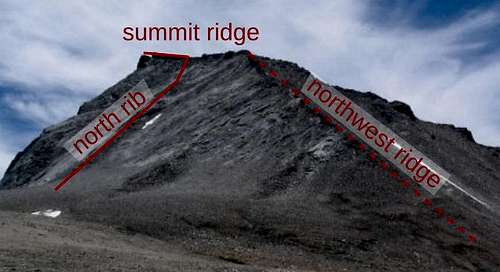|
|
Route |
|---|---|
|
|
36.65560°N / 118.3361°W |
|
|
Scrambling |
|
|
Half a day |
|
|
Class 3 |
|
|
Getting There
The shortest approach is over Shepherd Pass from the Shepherd Pass trailhead, near Independence. The last few miles of the road may require a four-wheel drive vehicle, and road conditions may vary from year to year. If you have a low-clearance vehicle, another option is to park at the point marked "Gaging Station" on the USGS topo and hike along a feeder trail that parallels a (probably dry) section of Symmes Creek.Camping
Possible places to camp are Anvil Camp, the forest in the Tyndall Creek drainage, or on the plateau above Shepherd Pass, at either of the two lakes. The plateau is nice and close to the base of the climb, but has little shade and may be windy.
Route Description
This class 3 route is the shortest way up Mt. Tyndall, and it offers more straightforward routefinding than the class 2 northwest ridge.From Shepherd Pass, hike 3/4 of a mile southeast to the south side of the smaller, second lake. You will see three ridges. In order from right to left, these are the long, low-angle Northwest Ridge; a short, less obvious ridge that points up toward the Northwest Ridge; and in front of you a long, visually prominent ridge, the North Rib, that leads all the way up to the near-horizontal summit ridge.
To climber's right of the North Rib is a gully that often holds a snow field persisting into August. Farther out on both sides are featured, low-angle, exposed class 3 slabs criss-crossed by diagonal cracks and narrow ledges.
Climb the talus pile to gain the rib. Once on the rib, rock quality is pretty good, although you should still wear a helmet and be careful. Scramble directly up the rib, detouring 10 or 20 feet to the left in a couple of places to avoid more difficult climbing. It is never necessary to veer far enough off of the rib to get onto the slabs. As you approach the near-horizontal summit ridge, you will see a series of similar-looking notches. Continue along the line of the rib, or slightly left, to the leftmost of these notches. (The other notches, to the right, are class 5.) Continue along the summit ridge to the top.
When you stand at the base of the climb, the gully to the right of the rib may appear less exposed and easier. It isn't. The rock quality is poor, and at certain points you will be forced out onto the more exposed slab to the right. You may also be forced out of the gully to avoid a snow field.
Descend by the same route, or the northwest ridge.


SchwartzOn - Sep 24, 2016 12:08 am - Voted 9/10
Variation NW RidgeIf you like ridges and traverses, the Northwest Rib is a longer more sustained Class 3 climb. Start at the Northwest rib, and ascend to the ridge where it is at a 45 degree angle, then climb the talus pile behind it until the Ridge drops off, and then climb along the East side of the Ridge to the Summit Plateau. Much more time up high on the ridge, and easy slab walk up. The ridge itself is vertical slab, and the higher you are on it, the more vertical it is. There is great footing up there, so no problem. See pictures.